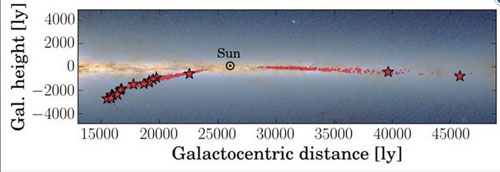An international team led by Cristina Chiappini from the Leibnitz Institute in Potsdam, and in which participate many scientists from the CoRoT team of the Paris Observatory’s Laboratory for Space Science and Astrophysical Instrumentation - LESIA - has discovered a mysterious group of red giant stars : with a chemical composition like that of old stars, their seismic properties are nevertheless those of young stars.

The very existence of these objects suggests that the standard model of the chemical evolution of the Galaxy is incomplete. It is probably far more complex than we thought.
Galactic Archeology
Galactic archelology presupposes that the history of our Galaxy is encoded both in the abundances of the various chemical elements which one sees, and in the proper motions of the stars.
A basci tool in this discipline is the use of abundance ratios to indicate age
While massive stars, which explose as supernovae following core collapse, enrich the interstellar medium with alpha elements [1]
on short time scales, type I supernovae produce iron peak elements on much longer time scales.
As a consequence, the interstellar medium is enriched in alpha elements much faster than in iron peak elements, so that the ratios of these abundances has been used traditionally as a chemical galactic clock.
Taking into account the seismic measurements of CoRoT
Seismology is now capable of giving very accurate measurements of stellar ages. Asterosismology, carried out by the CoRoT space mission, folllowed by the Kepler mission, measures the frequencies of stellar vibrations, which are intimately related to the internal structures of the stars, and thus to their ages.
« Taken separately, the measurements of the abundances and the seismiquc measurement are of course interesting as such, but only their comparison leads almost immediately to the ages of the stars. », emphasizes Benoît Mosser, university professor at the Paris Observatory, one of the French authrs of the paper.
The new set of stars CoRoGEE (standing for CoRoT APOGEE) is the result of a collaborative effort between the group « Red Giants » of CoRoT and the international team APOGEE (Apache Point Observatory Galactic Evolution Experiment) which, in the context of the Sloan Digital Sky Survey, has carried out a vast high resolution infra-red survey.
Thanks to this programme, it has been possible to do spectroscopic monitoring of hundreds of red giant stars for which CoRoT has furnished the seismic parameters.
Towards a more complex view of the chemical evolution of the Galaxy
The chemical clock works well for very many stars.
However, the CoRoGEE collaboration has discovered a group of relatively young red giant stars which are nevertheless enrich in aslpha elements with respect to the Sun.
This shows that the current model is probably over simplified, and should be improved.
At present, only CoRoGEE can investigate the inner parts of the galactic disc and determine in an independent way the ages of its stars. These observations will lead to a better understanding of their structure, and so lead to more exact models.
[1] The alpha elements are oxygen, neon magnesium, silicon, sulphur, argon, calcium and titanium. They are the products of the alpha reactions involving helium, and are thus named since the nucleui of their most abundant isotopes are made up of an integral number of alpha particles..
